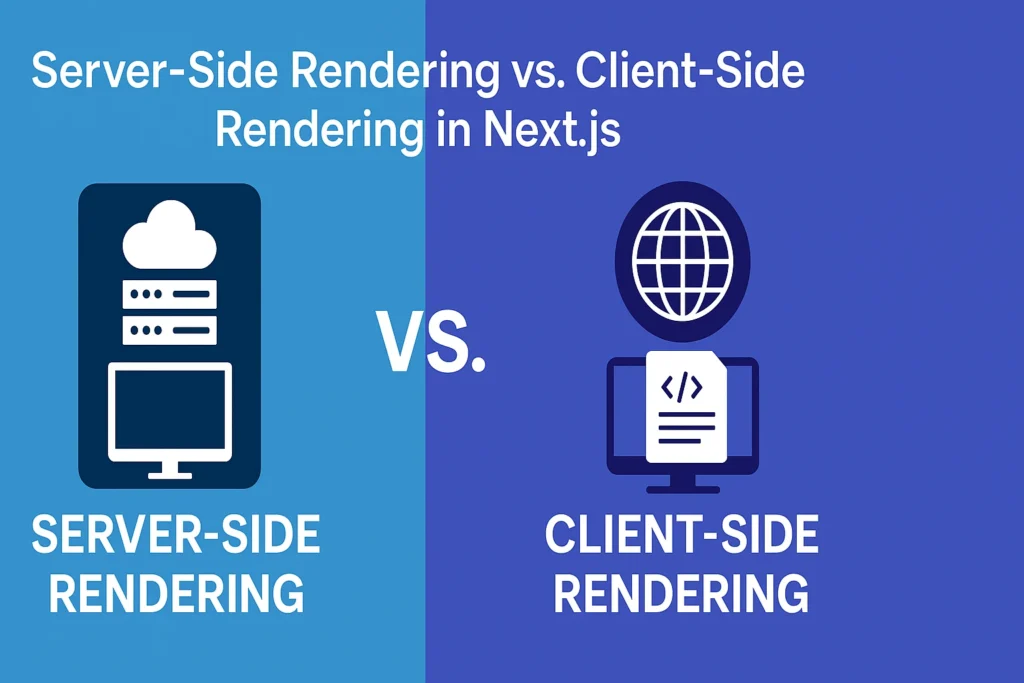📘 Server-Side Rendering vs. Client-Side Rendering in Next.js: A Complete Guide
Next.js is one of the most powerful React frameworks that supports both Server-Side Rendering (SSR) and Client-Side Rendering (CSR). Understanding when and how to use these rendering techniques can significantly affect your app’s performance, SEO, and user experience.
🔍 What is Server-Side Rendering (SSR)?
Server-Side Rendering means that the HTML of your page is generated on the server at request time. In Next.js, this can be done using getServerSideProps.
✅ Benefits of SSR:
- SEO-friendly: Search engines can crawl your content easily.
- Faster First Load: HTML is ready when the page reaches the browser.
- Fresh Data: Every request fetches updated content.
🚫 Drawbacks of SSR:
- Slightly slower response time compared to CSR.
- Higher server load for every page request.
🔧 How to Implement in Next.js:
export async function getServerSideProps(context) {
const res = await fetch('https://api.example.com/data');
const data = await res.json();
return {
props: { data },
};
}
🖥️ What is Client-Side Rendering (CSR)?
Client-Side Rendering loads a basic HTML page and uses JavaScript to fetch and render the content in the browser. In Next.js, this happens automatically with standard React components or using useEffect.
✅ Benefits of CSR:
- Less server load.
- Snappy page transitions.
- Great for user dashboards, SPAs, and private pages.
🚫 Drawbacks of CSR:
- Not SEO-friendly by default.
- Slower first load (blank screen until JS loads).
🔧 How to Implement in Next.js:
import { useEffect, useState } from 'react';
function Page() {
const [data, setData] = useState([]);
useEffect(() => {
fetch('https://api.example.com/data')
.then((res) => res.json())
.then((data) => setData(data));
}, []);
return <div>{JSON.stringify(data)}</div>;
}
⚖️ When to Use SSR vs. CSR?
| Use Case | SSR | CSR |
|---|---|---|
| SEO Pages (Blogs, Home) | ✅ Yes | 🚫 Not Ideal |
| Dashboards/User Profiles | 🚫 Not Ideal | ✅ Yes |
| Frequently Updating Data | ✅ Yes | ✅ Yes (with SWR) |
| Static Content | ❌ Prefer SSG | ✅ Yes |
🧠 Bonus: Want the Best of Both?
Next.js also supports:
- Static Site Generation (SSG) – perfect for blogs and marketing pages.
- Incremental Static Regeneration (ISR) – re-generate static pages in the background.
Learn more about Static Site Generation in Next.js →
🔗 Internal Links You Might Like:
- Getting Started with Next.js
- How to Use getStaticProps and getServerSideProps
- Optimizing Performance in Next.js
📝 Conclusion
Choosing between SSR and CSR in Next.js depends on your app’s goals. SSR is great for SEO and fresh data, while CSR works best for interactive, private, or post-login areas.
Let me know if you want this turned into a WordPress post, markdown format, or published in a CMS!









